Files Backup Plan in Management Console (NBF)
Use the remote management tools to create files backup plans in the new backup format on remote computers.
This chapter covers the following topics:
- File backup plan overview
- Create new file backup plan
- Run the Backup Plan
- Force Full Backup
- Edit the Backup Plan
- Clone the Backup Plan
- Delete the Backup Plan
File Backup Overview
Features:
- Local and network file backup
- NTFS permissions backup (Windows only)
- Synthetic Full backup
- Advanced file filter
- Compression and Encryption
- Regular retention policy for backups
- Forever Forward Incremental Backup
- GFS retention policy
- Object Lock (Immutability)
- Filename encryption
- Pre/post actions (Windows only)
Required License: Any valid backup agent license (To learn more, refer to Backup Agent License Type)
Create a Backup Plan from Scratch
Open the Management Console.
Open Backup > Computers page in the new main menu.
Find the required computer, then click the Configure icon in the Backup Plan Status column.
On the Backup Plans tab of the side panel, click + or +Add New Plan.
In the drop-down menu, select Files backup plan.

Welcome
The step in creating a new backup plan is to give it a name. Once you have entered a name, click “Next”
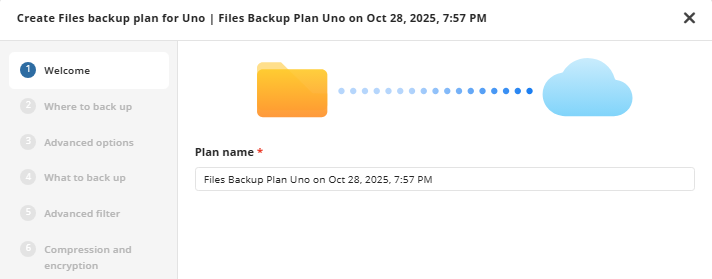
It is recommended that you select a name which helps you clearly identify the computer as well as the type of backup
In the new backup format, a backup plan configuration is always saved in a backup storage
Where to Back Up
Select a target backup storage for the backup plan. If no storage accounts are available, create a new one.

Once you select the backup storage, click Next.
Advanced Options
By default advanced options are skipped for the backup plan. You should enable them, if necessary (not recommended).
On this step you can specify the advanced options for the backup plan, exclude unnecessary contents.

- Synthetic Full backup. Select this option to enable Synthetic Full for selected backup storage. Consider, in case you enable this option for long-term backup storage, this can result in increased storage costs. Refer to your cloud storage provider documentation to check the prices of in-cloud copy creation for selected storage classes.
- Back up NTFS permissions. Select this checkbox to back up NTFS permissions assigned to your files, folders, and network shares in the backup plan at the moment of the backup plan execution
To learn more about NTFS permissions, refer to the NTFS permissions article
- Use fast NTFS scan. Enabling this allows the application to more quickly scan the NTFS file system for changes by using a low-level API, at the expense of increased local resource usage. The performance increase will likely only be noticeable when backing up a considerably large number of files and is also dependent on the type of device being backed up. The setting will not impact the speed of the initial full backup and will only be noticeable on subsequent backups.
Note that the Force Using VSS option is mandatory for fast NTFS scanning and will be enabled automatically
- Force using VSS. Select this check box to back up objects from a snapshot in order to avoid any access conflicts. This option is useful to back up files that are used by other processes at the moment of the backup plan execution
To learn more about VSS, refer to the Volume Shadow Copy Service (VSS) article
Consider the following restrictions that apply to VSS:
- VSS cannot be used to back up network files, such as network shares and mapped network drives.
- VSS cannot make snapshots of data stored in volumes with FAT32-partition.
Use system VSS provider. Select this check box in case you experience issues with a third-party VSS provider. Once the backup plan is run, the Backup Agent will use the system VSS provider forcibly
EFS Encryption
- Decrypt EFS-encrypted files. This option is selected by default: when selected, EFS-encrypted files are backed up in a decrypted state
- Keep EFS encryption. Select this option to back up EFS-encrypted files 'as is', in the encrypted state. Note that this option requires special attention since some issues decryption issues upon restore to a location other than the source computer may occur
Read more about backups of EFS-encrypted objects in the EFS-encrypted File Backup
Additional Advanced Options for Amazon S3
If your backup destination is Amazon S3, the following custom options are available in this step.
- Use S3 Transfer Acceleration. Use this option to accelerate file transfer for an extra fee. The target bucket must have this feature enabled
- Select the S3 storage class for the backup plan:
Using different storage classes for different backup purposes helps you to optimize the storage costs.
Learn more about Amazon S3 storage classes here
Additional Advanced Options for Microsoft Azure
If your backup storage destination is Microsoft Azure, and you have the General Purpose v2 Azure account, select the required storage class (access tier).
The following options are available:
- Hot tier. An online tier optimized for storing data that is accessed or modified frequently. The hot tier has the highest storage costs, but the lowest access costs.
- Cool tier. An online tier optimized for storing data that is infrequently accessed or modified. Data in the cool tier should be stored for a minimum of 30 days. The cool tier has lower storage costs and higher access costs compared to the hot tier.
- Cold tier.An online tier optimized for storing data that is rarely accessed or modified, but still requires fast retrieval. Data in the cold tier should be stored for a minimum of 90 days. The cold tier has lower storage costs and higher access costs compared to the cool tier.
- Archive tier. An offline tier optimized for storing data that is rarely accessed, and that has flexible latency requirements, on the order of hours. Data in the archive tier should be stored for a minimum of 180 days.
Note that this feature is only supported for General Purpose v2 Azure accounts. If you are using another kind of account, you need to upgrade your account to be able to use this feature
Be aware of the additional charges and increased blob access rates after your Azure account upgrade
To learn more about the difference between Azure storage tiers, refer to the Azure Blob Storage - Hot, cool,cold, and archive storage tiers article at docs.microsoft.com.
What to Back Up
Specify files and folders to be backed up.
| Check Box Appearance | Description |
|---|---|
 |
This folder with all sub items excluded. All new content will NOT be added |
 |
This folder with all sub items included. All new content will be added |
 |
Only selected items excluded. All new content in excluded folders will NOT be added |
 |
Only selected items included. New content will be added in selected folders only |

You can use Advanced options to add a network share to include it's content to backup scope:

- Expand Advanced options and click Add network share
- Provide the path to the network share in the following format:
\\<server name>\<share name>
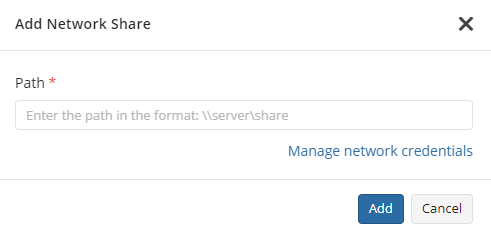
- Click Manage credentials and provide the credentials of the account with backup operator permissions on the network share.
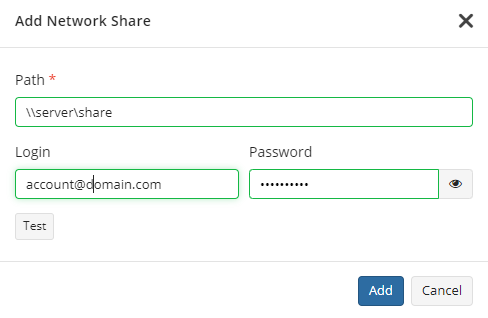
- Click Test to check whether the network share is accessible.
- Click Add
- Select files to back up on the added network share.
Consider that Managed Backup does not detect file changes based on content. Instead, it detects file changes by checking the modification date and uses this to determine whether a new copy of the file needs to be backed up.
On Windows system partitions it is recommended to only back up \Users\ folder. An Image backup is better suited to back up Windows and any other installed applications.
Databases cannot be backed up at the file level while in use. MSP360 MS SQL Server edition offers a robust solution for backing up active MS SQL databases.
Files and folders which are not accessible to the service account used by the backup plan will not be backed up and may cause the plan to fail.
For more advanced selection or the inclusion of a network share in the backup plan, click on the “Show summary” in Advanced options in the bottom. This will change the file browser window to a format which allows specific paths to be included or excluded by typing or pasting in the full path:
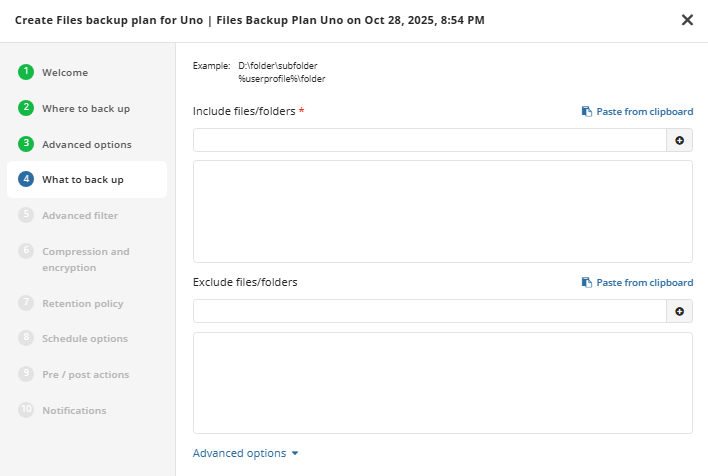
Advanced Filter
You can configure the criteria to include or exclude files/folders to backup.
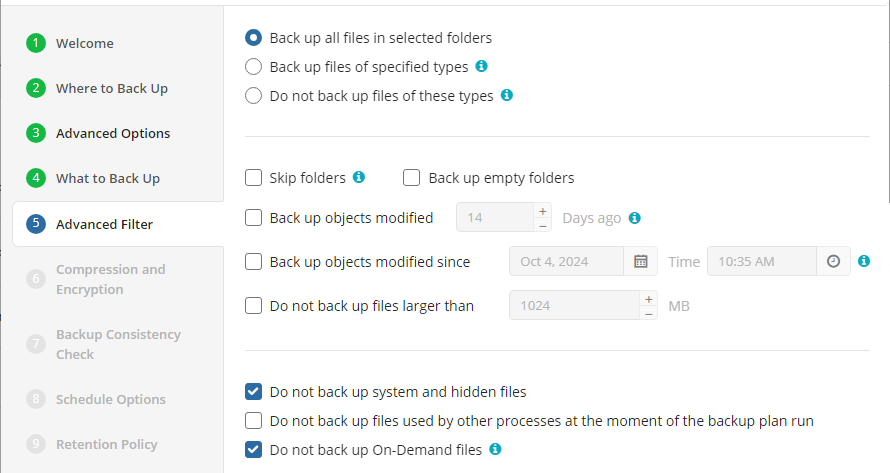
- Back up all files in selected folders. Select this option to back all files in folders, specified in the Backup Source section
- Back up files of specified types. Select this option to back up files of certain types. The file type is detected by file extension. In the field below, specify the required file extensions
- Do not backup files of these types. Select this option to exclude files of certain types from the backup plan. The file type is detected by file extension. In the field below, specify the required file extensions
- Skip folders. In this field, specify folders to be excluded from the backup plan. Separate them with semicolons
- Back up empty folders. Select this checkbox to include empty folders in the backup plan
- Back up objects modified. Select this checkbox, if you want to back up files, modified on a specific day. In the field below, specify the number of days from the last modification
- Back up objects modified since. Select this checkbox if you want to include in the backup plan all files that have been modified after a point in time. In the fields below, specify the date and the time of files modification
- Do not back up files larger than (MB). Select this checkbox to limit the size of files for the backup plan. In the field below, specify the maximum file size
- Do not back up system and hidden files. Select this option to exclude files that have 'system' and/or 'hidden' attributes from the backup plan. Refer to System and Hidden Files Backup for details
- Do not back up files used by other processes at the moment of the backup plan run. Select this check box, if you want to exclude from the backup plan files that will be opened at the moment of the backup plan run
- Do not back up On-Demand files (selected by default). Select this checkbox to exclude On-Demand files from the backup plan. Refer to OneDrive Backup in case you want to add this type of On-Demand files to backup
Compression and Encryption Options
Specify compression and encryption options for the backup plan.
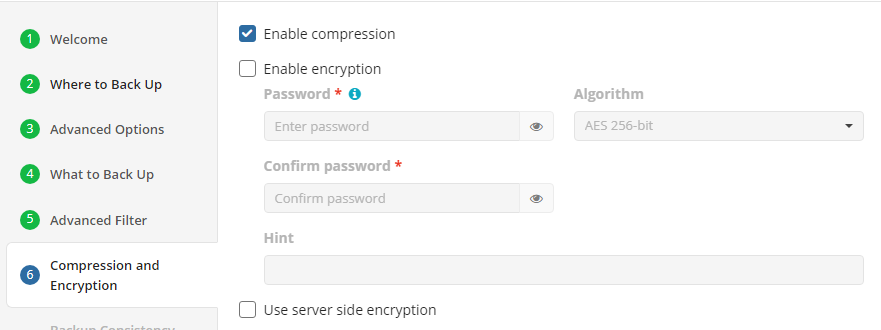
The following options are available:
- Select the Enable compression checkbox to compress backup contents to reduce the backup size on storage
- To protect your backup contents with encryption, select the Enable encryption check box. The following AES encryption bite key lengths are supported: 128, 192, and 256. Select the appropriate key length in the Algorithm drop-down menu
- Specify the encryption password in the Password field, then confirm the password in the Confirm field. Mind keeping the encryption password in a safe place. Pay attention, if Password Recovery Service is not enabled in the Management Console, then if the encryption password is lost or forgotten, the encrypted backup cannot be restored.
- In the Hint field, specify some information that could help to recall the password in case you forget it.
Backup Consistency Check
Specify whether a full consistency check is required for this backup plan. A mandatory consistency check will be completed with every backup plan run regardless of this setting.
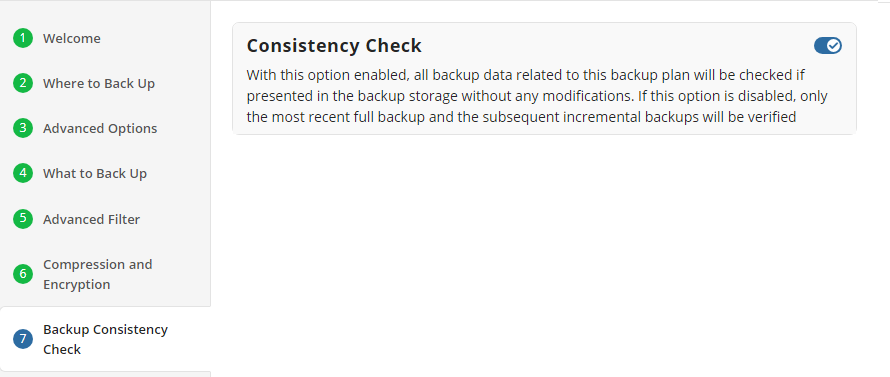
Full consistency check implements checks of data integrity for all generations (full and incremental backup sequences) except for the current generation check, which is the subject of a mandatory consistency check. A mandatory consistency check is performed at each backup plan run.
After the successful full consistency check, the backup data can be guaranteed to be restored.
Schedule Options
Specify the backup plan schedule settings.

The following options are available:
- Select the Simple option to apply the Forever Forward Incremental (FFI) schedule.
- Select the Advanced option to apply the recurring schedule and, if necessary, use Grandfather-Father-Son and Object Lock (Immutability).
- Select the No schedule, run manually option to run the backup plan manually. Retention policy will not work for this option.
The simple schedule is unavailable if the selected storage account does not support synthetic full backups.
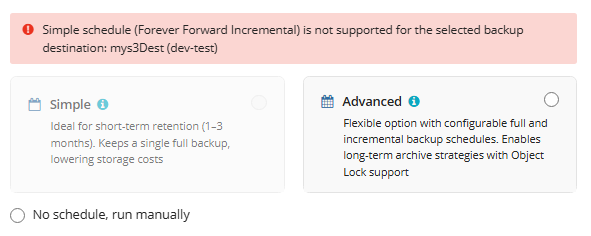
For more guidelines on schedule selection, refer to the following article.
Simple Schedule
Select the Simple option to use the Forever Forward Incremental (FFI). This schedule offers one full backup followed by a limited number of incrementals. Once the limit is exceeded, a new full backup is created using in-cloud copying (synthetic full backup.
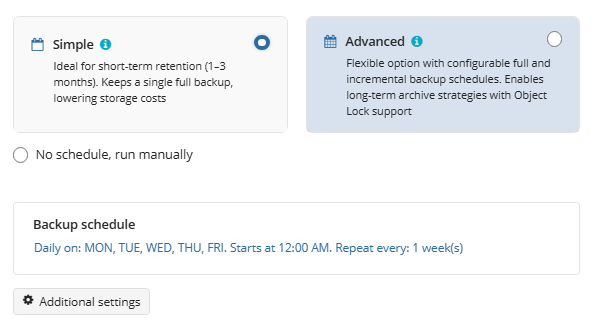
Once you select this option, the predefined schedule will appear. You can edit this schedule, if necessary. You can select the Daily or Monthly schedule type, depending on how often the incremental backups will be performed.
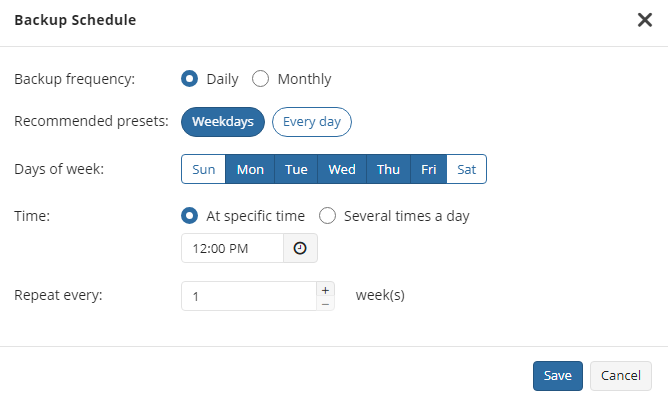
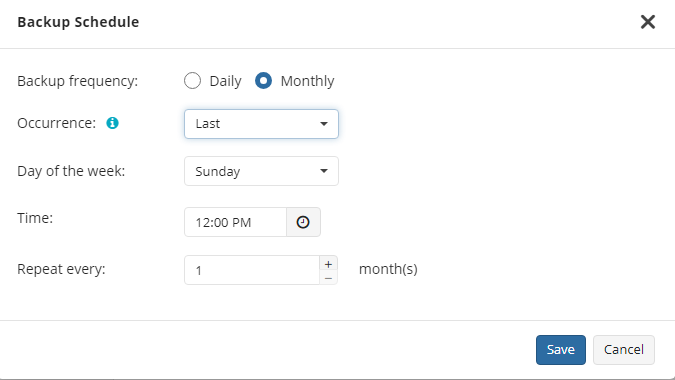
Use the Additional Settings to configure the following:
- First backup start date
- Stop condition for the long backup
- Overdue alert condition
- Missed backup handling
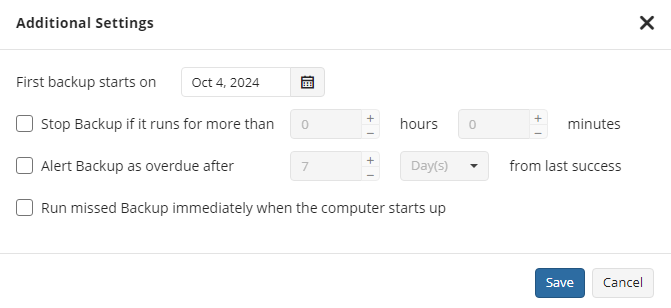
Advanced Schedule
Select the Advanced option to set up a flexible, recurring schedule with generations. Every generation contains one full backup followed by incrementals.
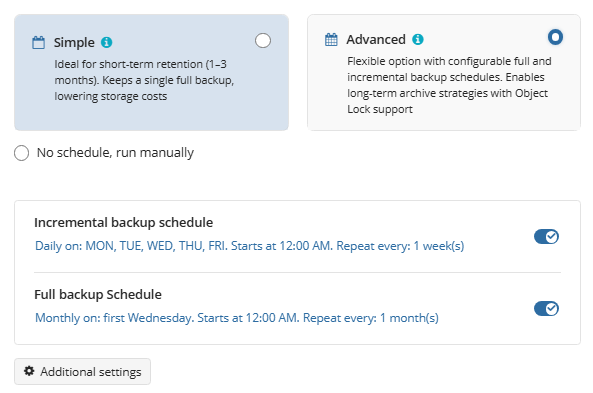
Once you select this option, the predefined schedule for full and incremental backup will appear. You can edit this schedule, if necessary.
The advanced schedule allows you to configure a flexible backup plan according to your requirements. To modify the schedule, use the edit icon next to the selected schedule. If needed, you can disable the incremental backup schedule to run only full backups.
You can select the Daily or Monthly schedule type, depending on how often the incremental backups will be performed.


Use the Additional Settings to configure the following:
- First backup start date
- Stop condition for the long backup
- Overdue alert condition
- Missed backup handling

It is recommended to schedule full backup at least once every 3 months for selected schedule
Schedule Options: Backup Agent v 7.9.7 and lower for Windows
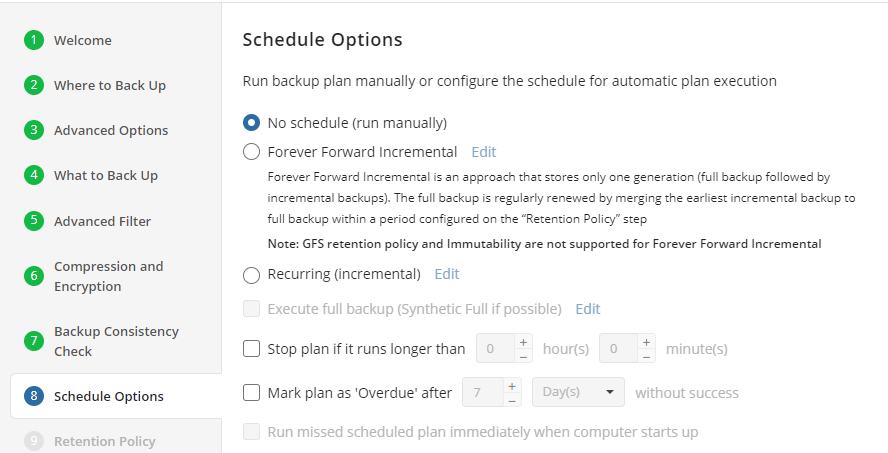
The following schedule options are available:
- Select the No schedule option to run the backup plan manually.
- Select the Forever Forward Incremental option to apply the Forever Forward Incremental (FFI) schedule, then specify the schedule parameters
- If you want the backup plan to run incremental backups on a constant periodic basis, select the Recurring (incremental) option, click Edit, then specify the settings for incremental backup plan runs
- If you want the backup plan to run full backups on a constant periodic basis, select the Execute full backup (synthetic full if possible) option, click Edit, then specify the settings for full backup plan runs
- To stop the backup plan in case if it continues suspiciously long, select the Stop the plan if it runs for... option, then specify the backup plan's maximum duration
- Select the Run Missed Scheduled Plan Immediately When Computer Starts Up option to run the plan that was not executed while the computer was down.
It is recommended to schedule full backup at least once every 3 months for selected schedule
Recurring Schedule for Incremental Backups
You can set the periodic run intervals for incremental backups. Specify if the incremental backup plan runs on a daily or monthly basis, then specify the recurrence parameters and start time. Click Save. It is recommended to set the periodic run intervals for full backups as described below, it is not recommended to use incrementals only. You can check your settings at the bottom of the step page.
Recurring Schedule for Full Backups
You can set the periodic run intervals for full backups. Specify if the full backup plan runs on a daily or monthly basis, then specify the recurrence parameters and start time. Click Save. You can check your settings at the bottom of the step page. In case you want to enable GFS on the next step, you should configure a full backup runs accordingly.
Schedule for Forever Forward Incremental Backup
Refer to Forever Forward Incremental chapter for details.
Retention Policy for Advanced Schedule, GFS, and Object Lock (Immutability)
If the Advanced schedule was selected, specify the retention period for the backup plan.
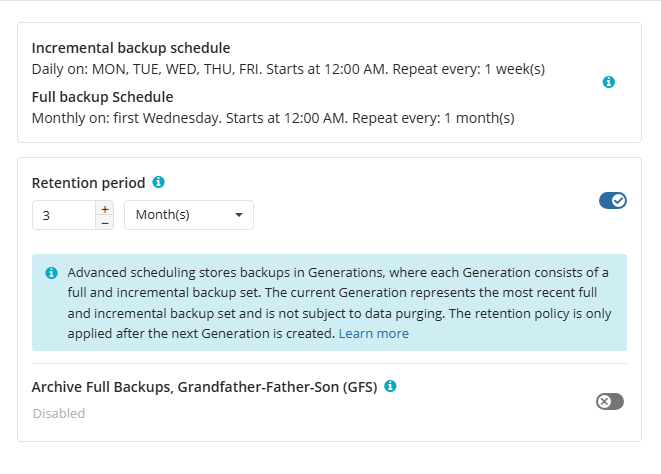
GFS Settings
To apply the GFS retention policy, enable the Archive Full Backups, Grandfather-Father-Son (GFS) feature, then specify the GFS retention settings.
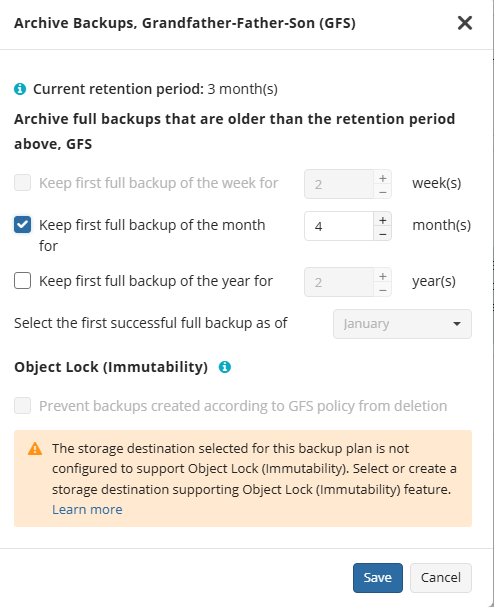
Learn more about GFS retention settings in the GFS Examples chapter
Object Lock (Immutability)
Object Lock (Immutability) is linked to the GFS retention policy. If the Object Lock (Immutability) is applied along with GFS settings, full backups that are subject to the GFS retention policy become immutable for the GFS keeping period.
Select the Prevent backups created according to GFS policy from deletion checkbox, then confirm the use of this feature.

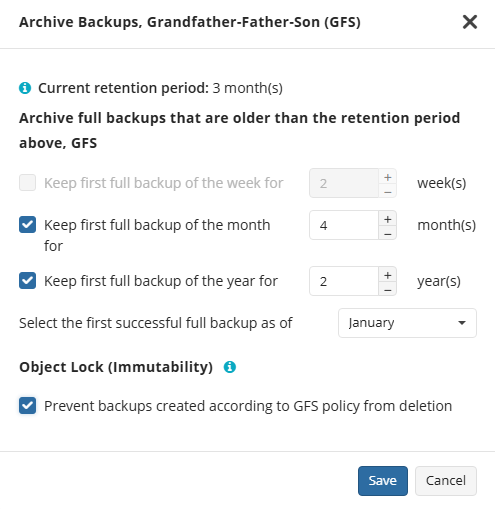
Use the Immutability feature with extreme caution. Once a backup data becomes immutable in Compliance mode, there is no way to delete them from the storage until the specified GFS keeping period expires except for the storage account termination. Incorrect settings can cause high storage bills.
To find more information about the Object Lock feature, supported storage providers, and required permissions, refer to this article.
Retention Policy for Simple Schedule
If on the Schedule options step you selected the Simple schedule, the Retention Policy step has different settings.
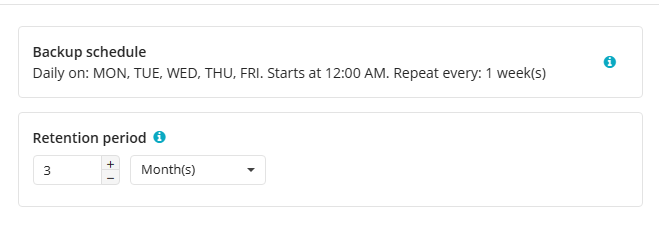
The Retention period value defines how long restore points are kept. Restore points with an expired retention period are merged into a full backup. (With Forever Forward Incremental, only one full backup is kept on the backup storage). If your storage has a minimum retention period, the creation of a new full backup will be postponed to avoid early deletion fees.
Pre / Post Actions
Specify pre and post-actions for your backup plan. Usually, these are scripts that perform particular jobs before or after your data is backed up. The following settings are available:

- To specify the action that will be performed before the backup plan starts, select the Pre-backup action check box.
- Specify the path to the script to be run as a pre-backup action.
- Specify the conditions of pre-action run:
- Select the Do not run the backup plan if the pre-backup action fails option if you do not want the backup plan to be launched if the pre-backup action fails.
- Select the Run the backup plan if the pre-backup action fails option if you want the backup plan to launch regardless of the pre-backup action result.
- To specify the action that will be performed after the backup is completed, select the Post-backup action check box.
- Select the Execute the post-backup action only if the backup plan completes successfully option if you want to run it only if the backup was executed without any errors or warnings.
- Select the Execute the post-backup action regardless of the backup plan result option if you want the post-action to be launched regardless of the backup termination results.
- To chain the backup plan with another plan, select Backup chain check box, then select the backup or restore plan name in the drop-down menu.
- Select the Run the selected plan if this backup plan completes with success option if you want to run the specified plan only if the backup plan was executed without any errors or warnings.
- Select the Run the selected plan regardless of this backup plan completion result option if you want the chained backup plan to be launched regardless of the backup termination results. Select the mode for the current chained backup plan:
- Force full backup. Full backup will be forced for the chained backup plan.
- Use settings of the current backup plan. Chained backup plan will be run as full or incremental, according to this backup plan run.
Notifications
Specify notification settings for backup plan results. You can use the company notification settings or customize them as needed. You can specify the required recipients and customize the notifications on different backup plan results:
- Success
- Warning
- Failed
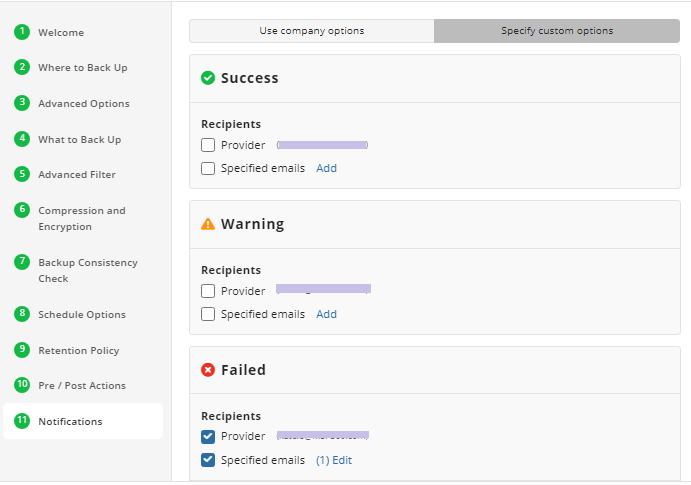
You can configure a notification threshold for Managed Backup alerts, so that notifications are sent only after a specified number of consecutive plan failures

In case you select to customize notifications, select the recipients for different events.
- Select Send notifications to user account... if you want to notify the associated user about the backup process.
- Select If the backup plan fails or completes with warnings option if you want to receive the notification message in case of the backup plan failure
- Select In all cases option if you want the entry to be put in Windows Event Log in any case.
Click the Next, then click Save to finish the wizard.
Run Backup Plan
To Run the Existing Backup Plan:
- Open Backup > Computers.
- Find the required computer, then click the Configure icon in the Backup Plan Status column.
- On the side panel, navigate to the Backup Plans tab
- Find the plan to run.
- Click the Start button to run the backup plan. You can expand this control to use the following options:
- Run Backup
- Force Full Backup
- Force Synthetic Full Backup
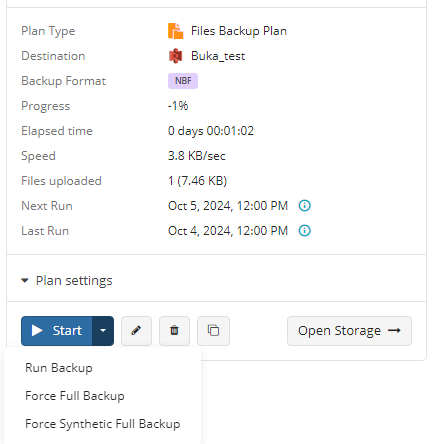
Force Full Backup
To Force Full Backup
- Open Backup > Computers.
- Find the required computer, then click the Configure icon in the Backup Plan Status column.
- On the side panel, navigate to the Backup Plans (Beta) tab
- Find the plan to force.
- Expand the Start control and click Force Full Backup.
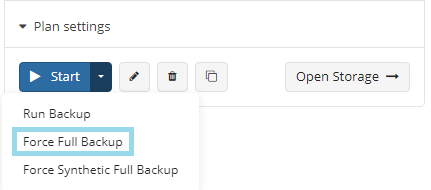
To configure regular full backup settings, refer to the Schedule step of the backup wizard
Edit Backup Plan
To Edit the Existing Backup Plan
- Open Backup > Computers.
- Find the required computer, then click the Configure icon in the Backup Plan Status column.
- On the side panel, find the plan you want to edit, then click the edit icon.

- Once you made the required changes, click Save.
Clone Backup Plan
To Clone the Existing Backup Plan
- Open Backup > Computers.
- Find the required computer, then click the Configure icon in the Backup Plan Status column.
- On the side panel, find the plan you want to clone, then click the clone icon.

- Specify the name of the plan clone.
- Click Save.
Delete Backup Plan
To Delete the Existing Backup Plan
- Open Backup > Computers.
- Find the required computer, then click the Configure icon in the Backup Plan Status column.
- On the side panel, find the plan you want to delete, then click the deletion icon.

- In the dialog box, click OK to confirm the deletion.
| Top |